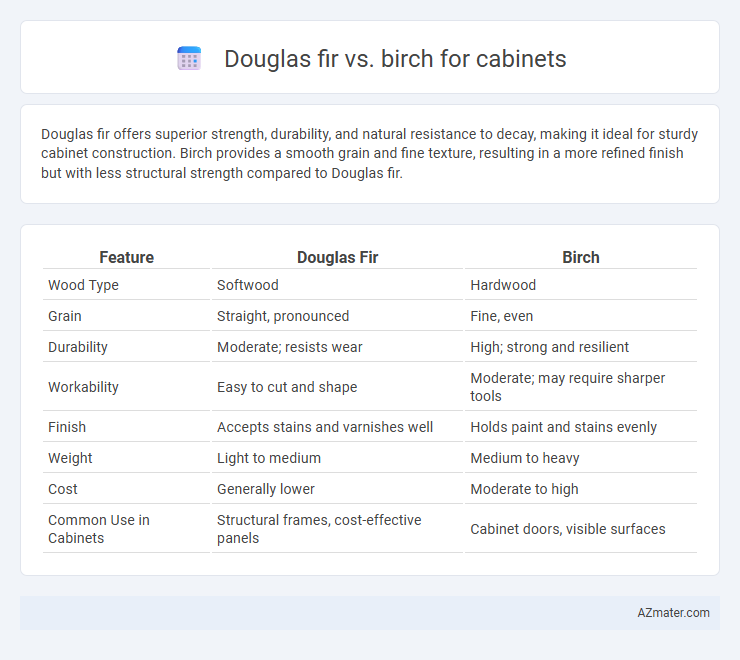Douglas fir offers superior strength, durability, and natural resistance to decay, making it ideal for sturdy cabinet construction. Birch provides a smooth grain and fine texture, resulting in a more refined finish but with less structural strength compared to Douglas fir.
Table of Comparison
| Feature | Douglas Fir | Birch |
|---|---|---|
| Wood Type | Softwood | Hardwood |
| Grain | Straight, pronounced | Fine, even |
| Durability | Moderate; resists wear | High; strong and resilient |
| Workability | Easy to cut and shape | Moderate; may require sharper tools |
| Finish | Accepts stains and varnishes well | Holds paint and stains evenly |
| Weight | Light to medium | Medium to heavy |
| Cost | Generally lower | Moderate to high |
| Common Use in Cabinets | Structural frames, cost-effective panels | Cabinet doors, visible surfaces |
Introduction to Douglas Fir and Birch Woods
Douglas fir is a durable softwood known for its strength and straight grain, making it ideal for sturdy cabinetry with a warm, reddish-brown hue. Birch, a hardwood, offers a fine, even texture and pale cream color that provides a smooth surface and clean, modern appearance in cabinet design. Both woods present excellent stability and workability, with Douglas fir favored for rustic styles and birch preferred in contemporary settings.
Appearance and Grain Patterns
Douglas fir features a straight, prominent grain with a warm reddish-brown hue that adds rustic character to cabinets, while birch offers a smoother, more uniform grain with a lighter cream to pale yellow color, creating a clean and contemporary look. The distinct grain of Douglas fir showcases pronounced growth rings and resin canals, providing a textured, natural appearance, whereas birch's subtle grain pattern enhances cabinet surfaces with a soft, consistent finish ideal for modern designs. These contrasting grain patterns and colors make Douglas fir suitable for rustic or traditional cabinetry and birch preferred for sleek, minimalist cabinetry styles.
Hardness and Durability Comparison
Douglas fir is moderately hard with a Janka hardness rating around 660, offering reasonable resistance to dents and wear, making it suitable for cabinets in less demanding environments. Birch, particularly Yellow Birch, has a higher Janka hardness rating near 1260, providing superior durability and scratch resistance for high-traffic kitchen or bathroom cabinets. The increased hardness of Birch translates to better longevity and less surface damage, although Douglas fir's workability and natural resilience also make it a viable choice for cabinetry where moderate durability suffices.
Workability and Machining Properties
Douglas fir offers excellent workability due to its straight grain and soft texture, allowing for easy cutting, shaping, and sanding in cabinet making. Birch, known for its fine grain and hardness, provides superior machining properties with smooth finishes and precise detailing but may require sharper tools to avoid burnishing or tear-out. Both woods perform well, though Douglas fir is more forgiving for beginners, while birch excels in durability and detailed craftsmanship.
Cost and Availability
Douglas fir offers a cost-effective solution for cabinets due to its abundance and fast growth, making it widely available and affordable compared to Birch. Birch, known for its smooth grain and durability, tends to be more expensive and less readily available, especially the higher-grade varieties used for cabinetry. Budget-conscious projects favor Douglas fir for its price and accessibility, while Birch is preferred for premium finishes despite its higher cost and limited supply.
Finish and Stain Compatibility
Douglas fir offers a warm, reddish-brown hue with a pronounced grain pattern, making it highly receptive to a variety of stains that enhance its natural character without obscuring texture. Birch features a fine, even grain that absorbs stains uniformly, producing a smooth, consistent finish ideal for achieving both light and dark tones. Both woods respond well to oils and varnishes, but Douglas fir's open grain requires careful surface preparation to avoid blotching, whereas birch's dense structure ensures a more predictable staining process.
Environmental Impact and Sustainability
Douglas fir is a fast-growing softwood known for its sustainable harvesting practices, often sourced from well-managed forests that promote carbon sequestration and biodiversity. Birch, a hardwood, typically has a slower growth rate and may require more energy-intensive processing, resulting in a higher carbon footprint compared to Douglas fir. Choosing Douglas fir for cabinets supports lower environmental impact through reduced deforestation risks and faster forest regeneration cycles.
Best Uses for Cabinetry
Douglas fir offers outstanding strength and dimensional stability, making it ideal for structural cabinet frames and heavy-use areas. Birch features a smooth, fine grain and uniform texture, providing an excellent surface for staining and a refined, modern cabinet appearance. Both woods are durable, but Douglas fir excels in rustic or industrial styles, while birch suits contemporary and traditional cabinetry.
Maintenance and Care Requirements
Douglas fir cabinets require regular sealing and occasional reapplication of protective finishes to maintain their natural moisture resistance and prevent warping, especially in humid environments. Birch cabinets demand less frequent sealing but benefit from gentle cleaning to avoid surface scratches due to their softer wood grain. Both woods need dusting with a soft cloth and prompt spill cleanup to preserve finish quality and extend cabinet lifespan.
Final Recommendations: Choosing Between Douglas Fir and Birch
Douglas fir offers superior strength and a distinctive reddish-brown hue, making it ideal for durable, rustic-style cabinets, while birch provides a smoother grain and lighter color, perfect for modern, versatile cabinetry. Both woods accept finishes well, but birch's stability and fine texture ensure a sleek, consistent surface ideal for intricate designs. For long-lasting, visually striking cabinets with a warm tone, choose Douglas fir; for a clean, adaptable look with ease of staining, birch is the preferred option.

Infographic: Douglas fir vs Birch for Cabinet
 azmater.com
azmater.com